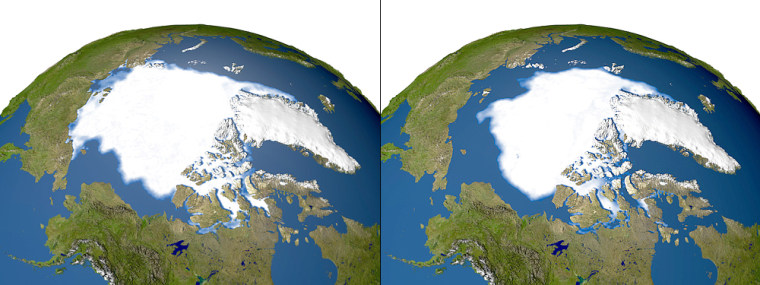New satellite observations show that sea ice in the Arctic is melting faster while air temperatures in the region are rising sharply, scientists say.
Since 2002, satellite data have revealed unusually early springtime melting in areas north of Siberia and Alaska. Now the melting trend has spread throughout the Arctic, according to a national collaboration of scientists.
The latest observations through September show that melting in 2005 began a record 17 days earlier than usual.
The observations showed 2.06 million square miles of sea ice as late as Sept. 19. That’s the lowest measurement of Arctic sea ice cover ever recorded, the researchers said. It’s also 20 percent less than the average of end-of-summer ice pack cover measurements recorded since 1978.
At the same time, average air temperatures across most of the Arctic region from January to August 2005 were as much as 5.4 degrees warmer than average temperature over the last 50 years, said the team of researchers from two universities and NASA.
“The melting and retreat trends are accelerating,” Ted Scambos, of the University of Colorado at Boulder’s National Snow and Ice Data Center, said in a statement released by the university. The results have not yet been published in a scientific journal.
“The one common thread,” Scambos said, “is that Arctic temperatures over the ice, ocean and surrounding land have increased in recent decades.”
'Best answer is warming'
The scientists stopped short of directly blaming the melting trend on global warming but said they have few other explanations at this point.
During the 1990s, a cyclical atmospheric circulation pattern called the Arctic Oscillation was believed to have been pushing sea ice out of the region and into adjacent waters. But the oscillation has weakened in recent years, and yet the melting continued and even accelerated.
“Something has fundamentally changed here, and the best answer is warming,” said Mark Serreze, another researcher at the snow and ice data center.
Sea ice records in the Arctic are sketchy before 1978. Since satellite observations began in earnest, researchers said Arctic ice has been retreating at a rate of more than 8 percent per decade.
And, they suspect, the melting may only contribute to even higher arctic temperatures in the future. That’s because the bright white ice tends to reflect more of the sun’s radiation. With more of the dark ocean exposed, the seawater tends to absorb more heat and reduce the amount of solar energy reflected back into space.
The researchers used satellite data from NASA, the National Oceanic and Atmospheric Administration and the Defense Department, as well as data from Canadian satellites and weather observatories.
The Colorado institute led the study that also involved two NASA laboratories, the National Oceanic and Atmospheric Administration and the University of Washington.
